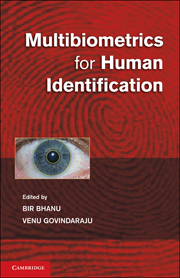Book contents
- Frontmatter
- Contents
- List of Contributors
- Preface
- Introduction
- PART I MULTIMODAL AND MULTISENSOR BIOMETRIC SYSTEMS
- PART II FUSION METHODS IN MULTIBIOMETRIC SYSTEMS
- PART III HYBRID BIOMETRIC SYSTEMS
- 8 Multiple Projector Camera System for Three-Dimensional Gait Recognition
- 9 Gait Recognition Using Motion Physics in a Neuromorphic Computing Framework
- 10 Face Tracking and Recognition in a Camera Network
- 11 Bidirectional Relighting for 3D-Aided 2D Face Recognition
- PART IV DATABASES AND SECURITY
- PART V PERFORMANCE OF MULTIBIOMETRIC SYSTEMS
- Plate section
8 - Multiple Projector Camera System for Three-Dimensional Gait Recognition
from PART III - HYBRID BIOMETRIC SYSTEMS
Published online by Cambridge University Press: 25 October 2011
- Frontmatter
- Contents
- List of Contributors
- Preface
- Introduction
- PART I MULTIMODAL AND MULTISENSOR BIOMETRIC SYSTEMS
- PART II FUSION METHODS IN MULTIBIOMETRIC SYSTEMS
- PART III HYBRID BIOMETRIC SYSTEMS
- 8 Multiple Projector Camera System for Three-Dimensional Gait Recognition
- 9 Gait Recognition Using Motion Physics in a Neuromorphic Computing Framework
- 10 Face Tracking and Recognition in a Camera Network
- 11 Bidirectional Relighting for 3D-Aided 2D Face Recognition
- PART IV DATABASES AND SECURITY
- PART V PERFORMANCE OF MULTIBIOMETRIC SYSTEMS
- Plate section
Summary
Introduction
The human body has fascinated scientists for thousands of years. Studying the shape of the human body offers opportunities to open up entirely new areas of research. The shape of the human body can be used to infer personal characteristics and features. Body type and muscle strength, for instance, can be used to distinguish gender. The presence or absence of wrinkles around the eyes and loose facial skin suggests a person's age. In addition, the size and shape of a person's face, belly, thighs, and arms can determine a body habitus: slim, healthy, or overweight. The length of individual limbs such as legs and their postural sway when a person walks suggests an underlying misalignment of the bone structure. It is, in fact, possible to identify people by their physical body shape of the entire body. Unlike traditional physical measures of height, width, and length of body parts, the body shape is represented by a closed surface of the entire human body as a 2-manifold. The surface is digitally captured and described by geometric primitives such as vertices, lines, and curves. It is useful for health professionals and technical experts to retrieve personal data from a shared database whenever the need arises. Using a large number of body shape measurements, valuable personal characteristics can be statistically analyzed. If there is a strong correlation between body shape and medical disease, for instance, we can avoid invasive diagnostic procedures such as medical imaging methods that utilize electromagnetic radiation.
- Type
- Chapter
- Information
- Multibiometrics for Human Identification , pp. 173 - 205Publisher: Cambridge University PressPrint publication year: 2011



